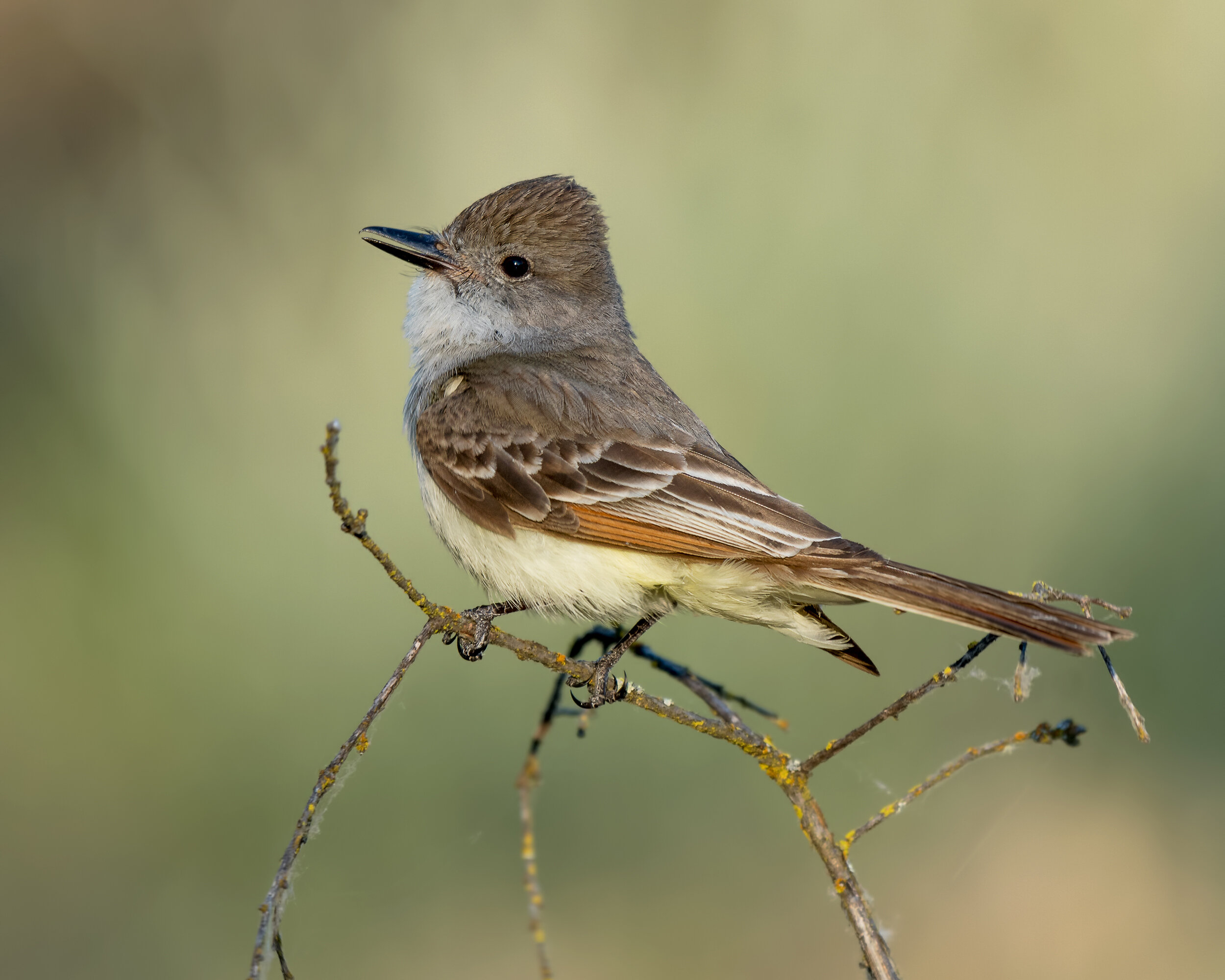Ash-throated Flycatcher, Image by Daniel Lee Brown
This month let’s learn about a bird in the flycatcher family called the Ash-throated Flycatcher (Myiarchus cinerascens). This species is common and widespread in the western regions of the United States. In the spring, Ash-throated Flycatchers migrate to find nesting sites in the western United States and in northern and central Mexico. In late summer or early fall, they migrate to western and eastern Mexico, Guatemala, and Honduras. There are populations of Ash-throated Flycatchers that remain in specific locations year-round in southern California, Baja California, and Mexico. In the Sacramento area we see Ash-throated Flycatchers primarily in the summer. They migrate to our area in late April, nest, raise their young, and leave the area beginning in early September.
Ash-throated Flycatchers typically have an erect posture when perched on twigs or low branches and remain fairly still when perched. When they take flight, there is often a burst of cinnamon color seen on their wings and tails. The same subtle colors of the Ash-throated Flycatcher’s plumage (or feathers) are often seen in nature. This enables Ash-throated Flycatchers to be well camouflaged.
What do Ash-throated Flycatchers look like?
Ash-throated Flycatcher, Image by Mary Forrestal
Male and female Ash-throated Flycatchers look the same and are around 7.5 to 8.6 inches in length. Male Ash-throated Flycatchers are usually slightly larger than females. Ash-throated Flycatchers have olive-brown backs, dark brown heads, sometimes a light gray neck collar, brown wings with white wing bars, rust-colored wing edges, whitish-gray throats and chests, narrow bills, black feet, long tails, pale yellow bellies, and the area on the belly (near where the tail begins) is also a pale yellow. The tails of Ash-throated Flycatchers have streaks of rust and brown feathers. They have a slightly peaked crests (a group of projecting feathers) near the back of their crowns (or heads). Juveniles are similar to adults. They are somewhat paler except for their tails. The tails of juvenile birds have a greater amount of bold rust color compared to the tails of adults.
Where do Ash-throated Flycatchers live?
Ash-throated flycatcher, Image by Larry Hickey
Ash-throated Flycatchers are found in a wide variety of habitats. They are most often found in dry, open habitats such as lightly wooded forests along rivers or streams, dry scrubby deserts, and chaparrals. Ash-throated Flycatchers will sometimes nest in grassland areas if nesting sites are available. However, they usually will avoid mountains and dense forests. Ash-throated Flycatchers do not need to drink water because they are able to get ample water in the foods they eat. This is the reason they can survive in very dry regions with high summer temperatures. In the Sacramento Valley, they are found in foothill locations and in oak woodlands.
Because they are cavity (or hole) nesters, Ash-throated Flycatchers seek habitats that have standing dead trees. Because they do not make new cavities, they need to find pre-existing ones. Ash-throated Flycatchers will nest in abandoned woodpecker holes and occasionally cactus holes. Because it can be difficult to find nest sites in dead trees (or other natural sources), they will also nest in artificial structures such as nest boxes, pipes, mailboxes, metal frames, fence posts, hanging articles of clothing, and ledges under eaves. Both the male and female help with nest construction. Ash-throated Flycatchers make the cup-shaped nests from strips of bark, grasses, twigs, weeds, and small roots. The nests are lined with mammal hair and soft feathers. The female Ash-throated Flycatcher usually lays eggs soon after the nest is completed, often in May. She incubates the eggs (keeps the eggs warm by sitting on them) for approximately 15 days. In the meantime, the male defends the nesting territory, brings food to the female, and provides extra materials for inside the nest. When the chicks hatch, their eyes are closed and they are bare-skinned. Both parents care for the nestlings. The young will leave the nest about 14-17 days after hatching. Usually, an Ash-throated Flycatcher pair will raise one brood (or group of young) in a nesting season. Pairs located in the more southern areas of the nesting range may raise two broods. An Ash-throated Flycatcher’s nest is usually found no more than 20 feet off the ground, however some nests have been found as high up as 70 feet. Pairs will sometimes reuse the same cavity for the following season.
What do Ash-throated Flycatchers eat?
Ash-throated Flycatcher, Image by Daniel Lee Brown
Ash-throated Flycatchers mainly eat insects and spiders. They help the environment by controlling insect populations and dispersing seeds. Ash-throated Flycatchers eat flies, larvae, bees, caterpillars, beetles, grasshoppers, moths, dragonflies, wasps, bugs, and sometimes cicadas. They will also eat fruit and berries, especially in winter. Rarely, they will eat small mammals and reptiles.
When foraging (hunting for food), Ash-throated Flycatchers fly for short distances to grab insects or spiders on the ground or on leaves in the lower parts of trees and bushes. Unlike many other flycatcher species, they don’t usually return to the same perch after flying to catch food nor do they usually catch insects in mid-air.
What do Ash-throated Flycatchers sound like?
The call of Ash-throated Flycatchers can be a useful identifier or clue to its presence. It is thought that one particular call sounds similar to an old-fashioned policeman’s whistle. Ash-throated Flycatcher calls have been described as sounding like: “ka-brick”, “burr”, “wheer”, “prrrt”, “pip”, and “zheep”. The song is a continuous but variable combination of their calls. You can listen now to Ash-throated Flycatcher calls and songs.
These songs and calls of the Ash-throated Flycatcher are from xeno-canto. More Ash-throated Flycatcher vocalizations can be found at xeno-canto.org/species/Myiarchus-cinerascens.




